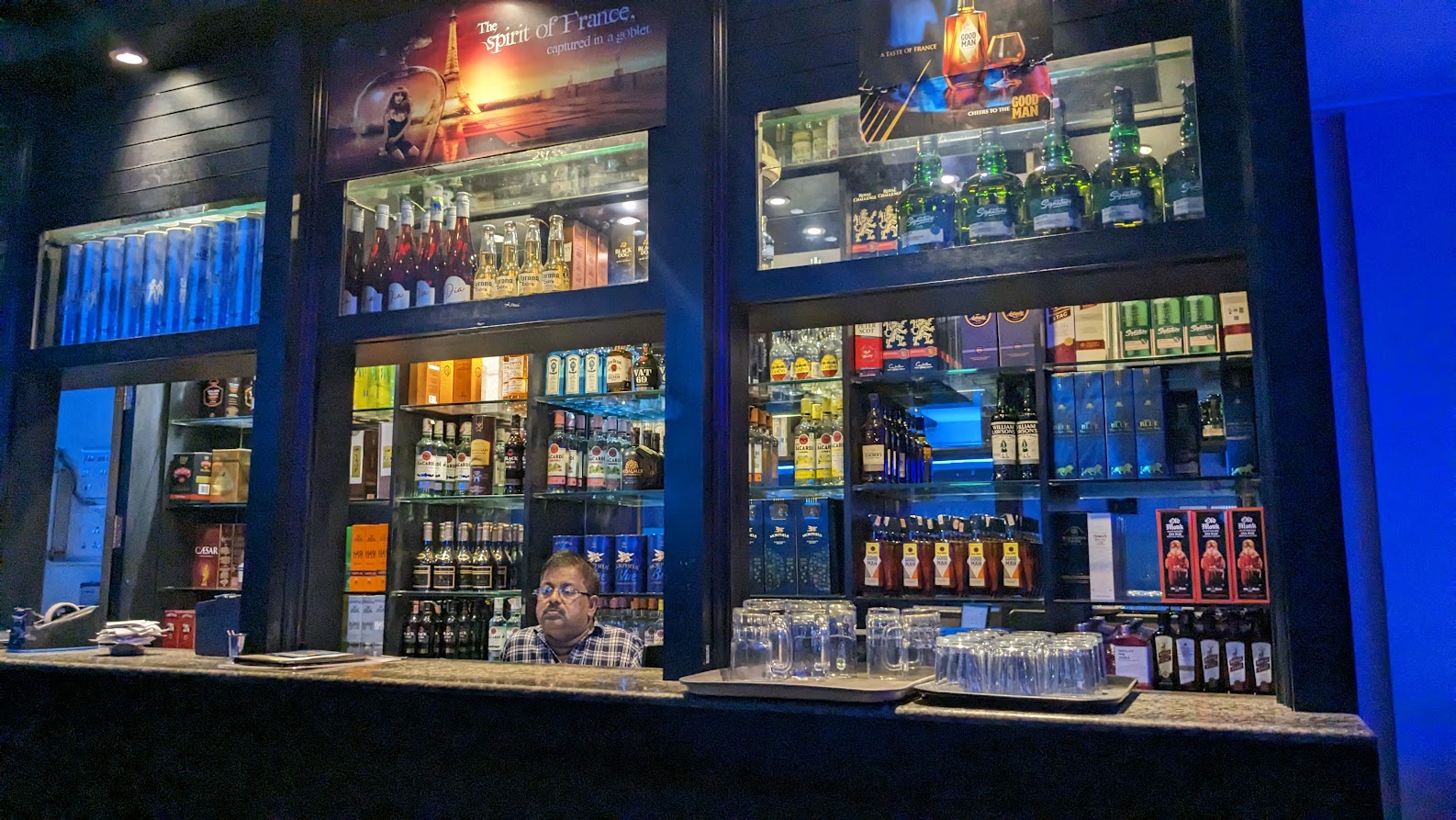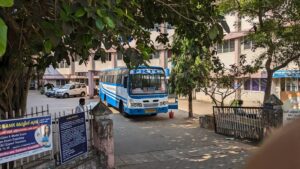Cheap liquor, petroleum and electrical goods make Mahe, a part of Puducherry, the tax haven of neighbouring Kerala.

Inside a liquor shop near the St Theresa's church in Mahe. Photo: K A Shaji
The statue of Marianne stands frozen in time amid an intrinsic melange of myths and legends that Mahe whispers to discerning listeners.
One among them is about the souls, now dragonflies, hovering over the Velliyan Rock — immortalised by M Mukundan in his Mayyazhipuzhayude Theerangalil, or On the Banks of the Mayyazhi.
The statue is a reminder of the French Revolution that ushered in a wave of romanticism, which the likes of Mukundan and others rode on, weaving magic that continues to enthrall literary enthusiasts across the world. But very few visitors are open to listening to Mahe’s tales.
Mayyazhi — now Mahe — of the 1940s that Mukundan introduced has changed in tune with the times.
The horse-drawn carriages that sped through the streets where wine flowed have given way to motorised vehicles, the clippety-clop of hooves merging with silence, and replaced by the hurly-burly of modern life.
But wine still flows: 64 liquor outlets and bars dotting the narrow lanes of Mahe, India’s smallest district spread over 8.69 square km — a slice of France of yore wedged between Kerala’s Kozhikode and Kannur districts.
For tipplers in Kerala’s Malabar region, the former French colony is paradise, where liquor is cheaper than in their home state, where they have to shell out around 240 percent as excise tax.
The liquor shops in Mahe are meant to cater its population of 41,816, who also have one college, one major hospital and a few schools.
Among Puducherry’s four districts, only Mahe is on the Arabian Sea: Others are on the shores of the Bay of Bengal. Puducherry, Karaikkal and Yanam are bigger than Mahe. A lone bus leaves Mahe at night to its capital city, Puducherry, located 610 km away. It is the only mode of public transport between the capital and the district.
Though known as a state, Puducherry is still a Union Territory, and central taxes are applicable. While a full bottle of white rum is available in Mahe for ₹650, it is being sold at ₹1,800 in Kerala.
Besides the liquor that attracts Keralites — evident from the many blacked-out guzzlers sleeping on its streets — fuel, construction and electrical materials, and vehicles, too, bring the Malayali hordes to Mahe.
In Mahe, petrol and diesel cost ₹13 lesser that their price in Kerala, tempting many in the neighbouring districts to tank-up their vehicles in the Union territory. Vehicles with Kerala registration plates are a common sight at the fuel stations in Mahe.
Taxes on new vehicles are also lower in Mahe. Gangs that organise fake temporary address documents for Keralites to purchase vehicles, too, thrive in the area. Liquor smugglers are also active in Mahe, who term their job extremely risky as Kerala’s excise and police departments check vehicles entering the state.
According to Mahe’s historian Varun Ramesh, very few from outside visit the place for its exceptional colonial heritage.

Mahe district administration office where the lone bus to Puducherry awaits passengers. (KA Shaji/South First)
The major attraction of Mahe is the St Theresa’s shrine, often referred to as the Mahe Church. Constructed in 1736, it is said to be the oldest church in South India.
Dedicated to St Teresa of Avila, the church on the highway is a popular destination for people of all faiths. The church now faces a problem: Tipplers hanging out in the church after downing a few pegs.
The Riverwalk is at heart of Mahe, a promenade on the banks of the Mayyazhi, the enclave’s very own French Riviera. Officially called Tagore Park, this landscaped oasis with its tall trees, meandering pathways, stunning views of the river, and estuary also holds some of its most important heritage structures.
Here too, several people, apparently drunk, could be seen sleeping.
The small stretch of land between Thalassery and Vadakara in Kerala came under French rule in 1721 and continued until the liberation in 1954. The Mayyazhi river passes through the old French settlement into the embrace of the Arabian Sea.
According to artist Paris Mohan Kumar, the little town with a small railway station, some old French churches, a few small temples, one mosque, six schools, one college and a major hospital does not have proper infrastructure.
However, he said it has emerged as a tax haven for Keralites. Interestingly, the Kerala Road Transport Corporation has asked the crew of its buses passing through Mahe to fill up the tanks in the Union Territory.
On Monday, 17 July, a litre of petrol in Mahe cost ₹93.80, while it was ₹108.19 at Thalassery in Kerala, 9 km away. Diesel price was ₹97.12 in Thalassery, while motorists got it for ₹83.72 in Mahe, a difference of ₹13.40.
Besides liquor, fuel is also being smuggled out of Mahe. If fuel is successfully transported in a 12,000-litre capacity tanker lorry, the profit is ₹1,20,000 per trip. Instance of authorities seizing smuggled petroleum products are on an uptick across Kerala.
Long-distance buses, and lorries, too, fill fuel from Mahe. Fuel station operators reported a significant spike in diesel sales after Kerala increased the prices by adding a social security cess. It is applicable to liquor also.
“Across India, only Mahe has such a high density of liquor shops. At every corner, you can see such shops and people drinking on the shop premises from early morning to night,” Mukundan said.
“Despite the easy availability of liquor, most people in Mahe are not drunkards. These shops are running exclusively for outsiders,” he pointed out.
“Mahe has become hell ever since Kerala increased taxes on liquor,” Pallian Promod, former councillor of Mahe municipality, said. “On dry days in Kerala, the outlets and bars are overcrowded with tipplers,” he added.
“Some alcoholics stay here for days or weeks to get cheap booze,” Mukundan said.
Though Kerala’s excise check-posts regularly monitor traffic on the national highway to Kannur and Kozhikode, the residents said that liquor smuggling is rampant here. Migrant workers are often hired to smuggle liquor.
Historians said Mahe was only a cluster of picturesque hills overlooking the Mayyazhi River and the Arabian Sea when the French Governor, Bertrand-François Mahé de La Bourdonnais, captured it from the Marathas in 1741.
A few hundred inhabitants, who lived at the foothills, cultivated rice and pepper, coconut and areca (betel) nuts. Most of the population belonged to the “low caste” Thiyya community. They ate steamed rice with spicy fish curry and worshipped numerous local deities, the fiercest of them being Kuttichathan, who abhorred Brahmins.
But their destinies and livelihoods soon changed once the French took over.
The French fought with the British on the seas and needed a base in southwestern India. Mahe, much to their relief, provided them the foothold. It also offered plenty of pepper, ginger, cinnamon and other spices.
French invaders grabbed these and ferried them to France. In the case of the local community, the French helped them shed their backwardness, educated them, and offered them jobs. Eventually, in place of semi-naked Thiyyas, who laboured in paddy fields and tapped toddy, a new class emerged — doctors and teachers educated in France who walked around with berets on their heads.
The town is also known for its political avant-garde. In the early 1940s, a young man from Mahe, Michilotte Madhavan, went to Paris for higher studies at the Sorbonne University. Attracted to the French Communist Party, he joined the resistance movement under Jean-Paul Sartre when France came under Nazi occupation.
The Nazis then captured the bespectacled young Indian, tortured him in jail and then shot him dead on 2 October, 1943. He is an unsung hero back home, but his name is inscribed on a memorial in France.
In 1954, the French handed over the reins of power to a local government led by IK Kumaran Master. This culminated in a long struggle spearheaded by the Mahajana Sabha, a party founded for Mahe’s liberation. The struggle sometimes turned violent, but it was generally a meek affair.
As the French left, hundreds of natives thronged the beach to bid them farewell. When the ship sailed towards the horizon, many wept. The question Mukundan’s character Damu poses to Kunhanandan Master might have then crossed many a mind: “Freedom? What does that mean, Master?”
But thanks to the French presence for over 200 years, Mahe has a place of its own in the decolonised country. The contributions of the French in terms of education and professional opportunities in France as well as exposure to modern civilisation, helped locals develop Mahe both economically and culturally.
Even today, the town is home to people who speak French.
“Amidst the huge rush from Kerala, Mahe is now bursting at the seams. It has to evolve much more than just be Kerala’s liquor and fuel outlets. Culture, heritage, and the uniqueness of Mahe must be celebrated and appreciated,” historian Ramesh said.

Jul 26, 2024

Jul 26, 2024

Jul 25, 2024

Jul 25, 2024

Jul 25, 2024

Jul 24, 2024